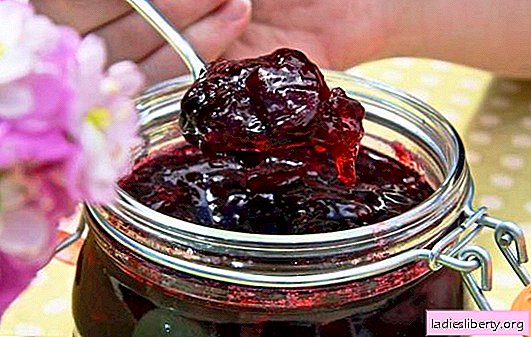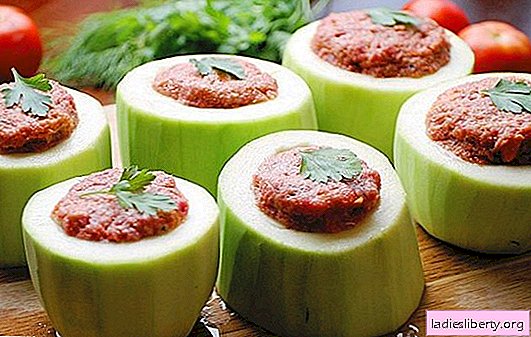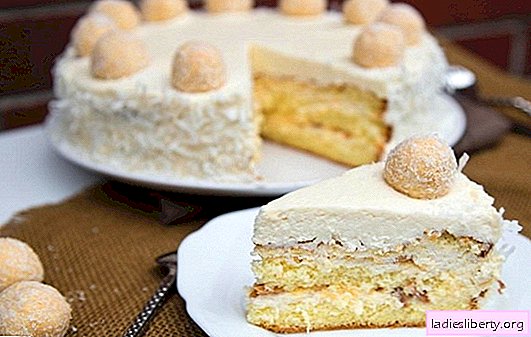
Petunia can now be found in any garden, she is loved by both beginners in floriculture and venerable landscaper professionals.
This is a multifaceted sorceress who can lead to affection as an elegant companion in a miniature pot composition and shock an avalanche of luxurious cascades in hanging pots.
Growing a petunia: a long way to success
In our country, petunia is known as a popular annual plant, but in fact it is, oddly enough, a perennial. In its homeland, in the tropics of South America, petunia is a perennial herb or semi-shrub. She - a typical representative of the family Solanaceae, among which are such known cultures as tomatoes, peppers, potatoes, and also tobacco.
At the end of the 18th century, a new flowering plant was discovered in Uruguay, which, according to a number of botany signs, was attributed to the family of the nightshade. Subsequently, together with other similar species, petunias were combined into a separate genus and named ... tobacco (Nicotiana axillaris) or "petun" in Brazilian style. True, we note in parentheses, it is not worth smoking the leaves of petunia, because there is a very small amount of alkaloid nicotine.
For two centuries, scientists have crossed all new varieties and hybrids, sometimes getting fantastic colors. By the middle of the 20th century, when the number of varieties of petunias exceeded hundreds, it was just a craze for this flower in the gardens of Western Europe, America, and Japan.
How to understand the abundance of forms and varieties of petunia
Now in the world there is such a variety of different variations, varieties, forms that can be understood and remembered only by narrow specialists, so that to simplify the presentation of information, conditionally everything Petunia varieties were divided into 4 groups:
• many-flowered (P. multiflora);
• large-flowered (P. grandiflora);
• floribunda (P.floribunda);
• ampelous (P. pendula).
The basis of the classification is taken form the bush and its height, as well as the type of flower and its size.

Different groups of petunias are perfectly combined in compositions.
The petunia flower corolla can be simple funnel-shaped, consisting of 5 fused petals, or it can be terry and semi-double. Terry petunia flower due to the transformation of ovaries into additional petals. This, by the way, explains the absence of seeds in flowers of this form.
The size and shape of the tube of a petunia flower can differ significantly among themselves. There are varieties with flowers that have small funnels, only 2.5 - 4 cm, but there are giants with a flower diameter of 14-15 cm.
The shape of the edge of the flower distinguishes varieties with a smooth edge of the corolla, there is also a strongly corrugated (fringed, wavy).
According to the shape of the bush varieties of petunias are divided as follows:
• bush (compact);
• pillow (sprawling);
• dropping (ampel).
The height of varieties vary as follows:
• compact (20-35 cm);
• sprawling (35-75 cm);
• ampelous (80-150 cm).
Below are brief characteristics of each group of petunias, indicating the most popular varieties.
Multi-flower petunia
Representatives of this group are most likely to be found in summer in every garden, since no variety of petunias possesses such unpretentiousness, early onset and total duration of flowering and, most importantly, resistance to adverse weather conditions: rain, wind and burning sun.
The height of the bush is from 20 to 35 cm, the flowers are small (3-8 cm in diameter), but there are so many of them that the green of the foliage is not very visible under the bright head of the inflorescences. To give the correct form a multi-flowered petunia can be (and even needed) to be cut, it very quickly gives additional shoots and buds, creating at the same time a smooth ball, very decorative and neat.
The color scheme when growing petunia is very diverse. Here are a huge number of red, pink, purple colors, various fantasy colors.
The most popular among the many-flowered petunias are the variety series:
• Duo (Duo)
• Bonanza (Bonanza)
• Fantasy (Fantasy)
• Prime Time (Prime Time)
• Merlin
Petunia grandiflora
The name of the group says that the feature of the petunias included in it is the large size of the flowers. The height of the bush can vary from 30 to 75 cm, and the shape - from round compact to creeping cushion. Let a sufficiently large value of 75 cm not mislead anyone - such tall specimens cannot be found in our area, this is the length of the stem that is creeping or hanging down.
Gorgeous flowers in this group. Large, from 6 cm and more, with rich colors from snow white to dark purple, they delight any viewer. Terry copies can give odds and to the queen of flowers - a rose, they are so gentle and luxurious.
Unfortunately, the magnificent appearance of the plant is very vulnerable and dependent on external conditions. Wind and rain are the main enemies when growing petunias. Raindrops easily tear the delicate petals and foliage, the flower completely loses its decorative effect and can start to rot. Moreover, the restoration of the bush occurs, unlike the small-flowered petunias, rather slowly. On average, under favorable conditions, the bush acquires the same elegant appearance only after 2-3 weeks.
It is best to admire these floral masterpieces under sheds and in places where there is no strong air movement. Large-flowered petunias as container plants on balconies, verandas, gazebos, as decorations on the porch of the house - these are the most optimal places for their placement.
From a large number of varieties, you can choose the most spectacular:
• Hit Parade
• Dreams
• Picotee Series (Pikoti Series)
• Limbo (Limbo)
• Frillytunia (Frillithunia)
Floribunda - petunia for flower beds
This group of petunias borrowed resistance to adverse conditions from multi-flower forms, and the large size of flowers from grandiflora. Very spectacular plants designed to decorate large tracts of flower beds look amazing in a group.
A great advantage of floribunda is considered to be wind and heat resistance, as well as the ability to “keep” rain well. Restores a damaged or trimmed plant very quickly.
For planting in the garden, you can recommend an unpretentious Celebrity (Silabriti), which will withstand the "field" conditions of urban flower beds and cope with errors in watering and dressing, and its spectacular 10-cm corollas have a lot of juicy shades in the series.
Ampel petunias
Recently, this group of petunias is very much in demand, since only one basket with waves of bright flowers can decorate an entire garden. Ampel petunias are represented by varieties whose shoots reach a meter long (and some even longer), with the growth of lashes genetically directed downwards.
Among the Ampels there are varieties that are resistant to rain and drafts, but, mostly, falling lashes should be protected from wind and rain, placing them under a canopy or raising under the roof during bad weather.
To the ampel (cascade) include such popular varieties as:
Wonder Wave F1 (Wonder Wave)
Opera F1
F1 supertunia
Surfinia
Explorer
Minitunia
Ramblin F1 (Ramblin) and Easy Wave (Easy Wave) are considered to be semi-flute, and they are well overgrown with not only whips, but also the “crown”, so they are willingly planted in low containers.
How to breed petunia yourself
Thanks to the amazing beauty of growing petunias, now both professionals and amateurs are engaged. How can you get this wonderful plant?
Almost all garden centers offer a good selection of seedlings of letniki, including petunias. Cassettes and containers with seedlings and sometimes already full blooming seedlings can be bought at fairly reasonable prices. Huge plus of buying plants in the form of seedlings is the ability to personally evaluate some qualities of the variety - the shape of the bush, the color and type of corolla.
The disadvantage of the method is a very small selection of varieties in the collections of shops, the impossibility of optimally selecting plants for the planned composition. The only way out of the situation can be the independent cultivation of petunias of the desired variety, since the seed assortment is excellent now.
Another method of reproduction of the variety that you like is cutting the masterbatch. Petunias get acclimatized when grafting, and soon after rooting the young bush blooms, completely repeating the qualities of the mother plant.
How to prepare for sowing seedlings of petunias
Seeds are sown from February to April. If it is not possible to make the seedlings illumination with special lamps (fluorescent or LED), then the planting is postponed until mid-March, when the light day becomes long enough.

Backlight for petunia is needed on cloudy days and in early spring
As a landing tank, it is convenient to use low (5 cm) containers, having made (necessarily!) Drainage holes at the bottom for draining excess moisture. Petunia, especially young specimens, does not tolerate stagnant water and may die.
The soil is prepared very light, making up a substrate of peat, humus, sod land and sand in equal proportions. If it is not possible to apply the above recipe, then buy the finished substrate in the store and add 1 part of sand to 4-5 parts of the finished soil.
Pre soil is disinfected, warming up 10 minutes in a large glass jar in the microwave or 40 minutes on the steam bath. The procedure is obligatory if you later do not want to engage in the treatment of seedlings from late blight and black legs.
Sterile soil after treatment is a poor substrate for plants, it is devoid of beneficial microorganisms. In this regard, they shed bags of prepared soil with one of their preparations: Baikal, Fitosporin, Alirin, Zdorovaya Zemlya and left it for a week or two in a warm place for the settlement of necessary bacteria and fungi.
How to grow healthy petunia seedlings
Prepared land is distributed in cassettes. It is better to sift the top layer through a sieve so that the lumps of earth do not interfere with the germination of small seedlings.
A well-established method of sowing "in the snow", when pure snow is poured over a layer of 1 cm over the ground, and then a toothpick is laid out with seeds that are clearly visible on a white surface. When the snow melts, the seeds are slightly drawn into the ground - just to the desired depth.
Ascended shoots protect both from excess moisture (condensation on the glass) and from dry air. It is desirable to water babies from a large syringe without a needle, otherwise even the narrow nose of the watering can is easy to wash off fragile stems. During the day, the temperature is maintained at + 20-23 ° C, at night + 16 ° C, under such conditions the plants do not stretch out and grow strong and stocky.
After the appearance of this leaf, the seedlings dive - sit on individual cassettes, as the grown bushes begin to grow rapidly and they need a lot of space.
Since the appearance of 3 of this leaf petunias feed regularly. While the babies are in cassettes, they are sprayed on the sheet alternately with solutions of humates, preparations Ferovit (contains iron) and HB-101 (immunostimulant).
We grow petunia in the garden
With the onset of warm days, seedlings of petunias are transferred to a permanent place of residence - in flower beds, hanging pots, containers. Usually bushes quickly take root, only in the case of strong heat or a cold snap can they be covered with a spunbond for protection from stress.
On a bed of flowers provide a well-lit place, filled with organic (just not fresh manure!) And complex fertilizers. During the season, flower beds are regularly watered with water, adding once a month the “For flowering plants” top-dressing with the predominant content of potassium and phosphorus.

Cascade Petunia Flowerbed
In addition, they regularly collect faded flowers and cut the lash if necessary to improve the shape of the bush.
When planting seedlings in containers and pots, one should keep in mind that growing petunias, especially ampelous, requires a large amount of land for normal growth - 5 liters per plant. Excessive thickening of the pot with plants in the hope of a “chic look” will lead to the opposite effect - whips will grow bald and stretch.
Despite the presence of fertile soil in the tanks (sod land, compost, vermiculite, peat), it is quickly depleted, because abundant flowering tolerates a lot of nutrients. Therefore, the container cultivation of petunia provides for constant feeding, both root and leaf. Flowers are watered with dissolved fertilizers 2 times a month and 2-3 times a month they carry out leaf top-dressings. Periodically, the soil is loosened and after watering, they pierce from top to bottom with a needle, aerating it. Do not be afraid to damage the plant - for easily recoverable petunia roots, this operation is painless, and the benefits of it are great.
We grow petunias: pests and diseases
During the period of growing petunias, they monitor the state of the foliage and, when it is yellowed, process the plant from spider mitewhich often settles on garden plants.
Treatments are carried out with acaricides (Actellic, Fitoverm) three times for 3 weeks (once a week). From aphids and thrips use any insecticides - Aktar, Inta-Vir, Iskra.
Of the diseases most often have to deal with powdery mildew, using one of the drugs - Scor, Topaz, Chistotsvet.
Sometimes with an excess of moisture and a lack of heat, petunia is affected by other fungal diseases - phytophthora, wet rot or brown spot.
In order for plants not to hurt, exclude the use of acidic soil, water stagnation. Preparations necessary in these cases: Profit Gold, Oxyhom.
Petunia in garden design
Due to the large number of groups of petunias, you can always choose the most suitable option for your garden. Among them are those that can act as an accent in the composition - these are, as a rule, varieties with bright colors, terry or with the original fantasy pattern.
There are some forms that can be used as borders in ridges and mixborders (for example, many-flowered). Due to the long flowering of such scenes for a long time remain bright and do not require special care.

Petunia as a border - an interesting option
Varieties with a compact bush and beautiful flowers are always in demand for filling balcony boxes and making small compositions in pots. And the cultivation of petunias in the form of chic ampels is suitable for decorating tall containers and hanging flower pots.
In addition to creating vertical volumes, amphels drape perfectly horizontal surfaces. They are used for decoration of carpet flower beds and decorating the shores of garden ponds.











